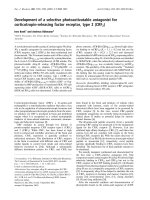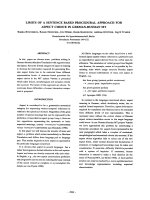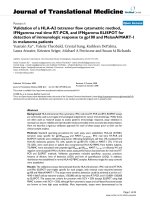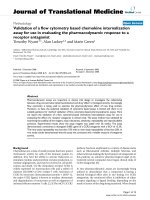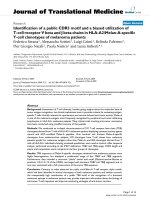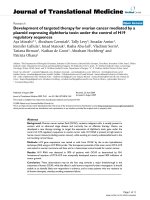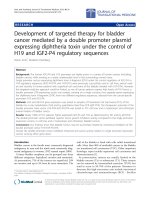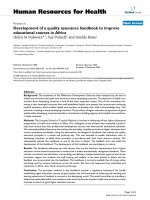Báo cáo hóa học: " Development of a 3D immersive videogame to improve arm-postural coordination in patients with TBI" potx
Bạn đang xem bản rút gọn của tài liệu. Xem và tải ngay bản đầy đủ của tài liệu tại đây (505.31 KB, 11 trang )
RESEARCH Open Access
Development of a 3D immersive videogame to
improve arm-postural coordination in patients
with TBI
Ksenia I Ustinova
1*
, Wesley A Leonard
1
, Nicholas D Cassavaugh
2
and Christopher D Ingersoll
1
Abstract
Background: Traumatic brain injury (TBI) disrupts the central and executive mechanisms of arm(s) and postural
(trunk and legs) coordination. To address these issues, we developed a 3D immersive videogame– Octopus. The
game was developed using the basic principles of videogame design and previous experience of using
videogames for rehabilitation of patients with acquired brain injuries. Unlike many other custom-designed virtual
environments, Octopus included an actual gaming component with a system of multiple rewards, mak ing the
game challenging, competitive, motivating and fun. Effect of a short-term practice with the Octopus game on arm-
postural coordination in patients with TBI was tested.
Methods: The game was developed using WorldViz Vizard software, integrated with the Qualysis system for
motion analysis. Avatars of the participant ’s hands precisely reproducing the real-time kinematic patterns were
synchronized with the simulated environment, presented in the first person 3D view on an 82-inch DLP screen. 13
individuals with mild-to-moderate manifestations of TBI participated in the study. While standing in front of the
screen, the participants interacted with a computer-generated environment by popping bubbles blown by the
Octopus. The bubbles followed a specific trajectory. Interception of the bubbles with the left or right hand avatar
allowed flexible use of the postural segments for balance maintenance and arm transport. All participants practiced
ten 90-s gaming trials during a single session, followed by a retention test. Arm-postural coordination was analysed
using principal component analysis.
Results: As a result of the short-term practice, the participants improved in game performance, arm movement
time, and precision. Improvements were achieved mostly by adapting efficient arm-postural coordination strategies.
Of the 13 participants, 10 showed an immediate increase in arm forward reach and single-leg stance time.
Conclusion: These results support the feasibility of using the custom-made 3D game for retraining of arm-postural
coordination disrupted as a result of TBI.
Keywords: virtual reality, motor rehabilitation, postural control, brain injury
Background
Approximately 3.2 million Americans live with long-term
disability following traumatic brain injury (TBI) [1]. The
majority of TBI survivors present with disrupted central
and executive mechanisms underlyin g arm and postural
(trunk and legs) coordination [2]. Behaviorally, such dis-
ruption limits postural stability when performing arm
movements, increases the risk of falling, deteriorates
motor skills, and eventually decreases the quality of life
of TBI survivors [3-5]. Despite the importance of arm-
postural coordination, surprisingly little attention is paid
to its restoration by conventional rehabilitation, which
generally treats the affected upper extremities, postural
control, and gait separately. This lack of attention is
related to the complexity of TBI-re lated coordination
deficits, inconsistency of evaluation, difficulties a ddres-
singaspecificproblemwithreal world coordination
tasks, and adapting these tasks to the abilities and needs
* Correspondence:
1
The Herbert H. and Grace A. Dow College of Health Professions, Central
Michigan University, MI, USA
Full list of author information is available at the end of the article
Ustinova et al. Journal of NeuroEngineering and Rehabilitation 2011, 8:61
/>JNER
JOURNAL OF NEUROENGINEERING
AND REHABILITATION
© 2011 Ustinova et al; licensee BioMed Central Ltd. This is an Open Access article distributed under the terms of the Creative
Commons Attribution License ( which permits unrestricted use, distribution, and
reproduction in any medium, provided the original work is properly cited.
of TBI survivors . Development of customized virtual rea-
lity (VR)-based gaming exercises and their imp lementa-
tion into TBI rehabilitation may solve this problem.
To date num erous custom-ma de VR applications have
been tested and shown to be effective in restoring sensori-
motor abilities in patients with acquired brain injuries.
Utilizing movements similar to those made in the real
world, VR games incorporate elements essential for suc-
cessful retraining. The games offer practice in various and
safe environments, allow manipulation with the timing
and precision of object interactions, provide real-time per-
formance feedback, and acknowledge a participant’ssuc-
cess relative to his/her abilities [6-10]. Although most
positive evidence has been collected in patients with stroke
[6,8,11,12], several studies reported the f easibility of VR
practice in patients with TBI [13,14]. The potential of VR
gaming applications has been verified in this population
when assessing cognitive functions [14,15], or retraining
functional skills [16,17] and balance [9,18,19].
Despite the high potential of VR games, some gaps
remain in their development as rehabilitation tools. Most
virtual environments use gaming concepts, which simply
simulate arm movements, balance, walking, and cognitive
tasks separately, with minimal attention paid to restoration
of specific motor deficits, such as complex whole-body
motions. This fact limits the use of VR applications in
patients with multiple TBI-related sensorimotor abnorm-
alities. Furthermore, most customized VR paradigms lack
actual gaming elements that could make the task challen-
ging, competitive, motivating, and fun. Virtual-reality para-
digms with built-in animation scenarios frequently ignore
the basic principles of game development, such as the
inclusion of a gaming story, conflict, reward system, and
level-based increases in difficulty. Most studies reported
results of practicing repetitive, stereotyped actions, as for
example pointing at a target in a simulated elevator [11]
or reaching to grasp simulated objects [12]. Designing vir-
tual environments which implement the principles of
game design would advance virtual rehabilitation in neuro-
logical populations.
While absent in custom-made virtual environments,
the above basic gaming elements are found in popular
“off-the-shelf” gamesofferedforexamplebyNintendo
Wii and Sony EyeToy. Unfortunately available as altern a-
tive therapeut ic tools, off-the-shelf games cannot replace
customized tasks because of the inflexible gaming con-
tent, absence of strict requirements for defining and
monitoring th e precision of motor performance, and lack
of equivalency to movements performed in the real world
[20,21]. For example, all large-amplitude whole-body
movements required for playing tennis can be replaced
with only one hand manipulating a Wii controller. Such
a distorted spatial calibration diminishes the rehabilita-
tion effect of this gaming system.
Considering the drawbacks of existing VR-based appli-
cations, we developed a customized videogame (Octopus)
for use by patients with TBI. Unlike many other custom-
designed virtual environments, Octopus focused on train-
ing arm-postural coordination, utilized the basic principles
of game design, and included tasks calibrated according to
the patient’s anatomical features and movement abilities.
This paper provides a description of the game design,
training protocol, and effect of a short-term gaming prac-
tice on the arm and postural coordination of patients with
mild-to-moderate TBI. Some results have a ppeared pre-
viously in abstract form [22].
Methods
Gaming system
The gaming system consisted of a Dell Mobile Precision
M6500 laptop (Intel i7 quad core CPU) with a graphics
accelerator (NvidiaQuadro FX 3800 M) integrated with a
6-camera system for motion capture (Qualisys AB,
Sweden). Participant interaction with the simulated vir-
tual environment occurred via hand avatars, precisely
reproducing the real-time kinematic patterns. The ava-
tars were created with 3 reflective markers (12 mm in
diameter) attached to each hand. The movements of the
markers were recorde d by the Qualisys system for
motion analysis at 100 Hz and then synchronized with
the VR gaming scenario with mini mum delay. The image
was projected in 3D format onto an 82-inch screen (1080
p Mitsubishi DLP
®
TV bundle, RealD) and was viewed
by the participant in the first-person view via shutter
glasses (RealD Professional CrystalEyes 5). The glasses
are emitter free and thereby caused no interference with
the infrared signal emitted by the motion capture system.
Wearing these light weight glasses (67 grams) posed
minimum constraint on participant’s movements.
The gamin g scenario was developed using WorldViz’s
Vizard software (WorldViz LLC) with computer gra-
phics c reated with Alias’ Maya package for 3D anima-
tion (Maya
®
, Version 7.0.1; Autodesk, Inc.).
Gaming Scenario
The game is designed to challenge postural stability while
reaching to intercept a moving target. In the gaming sce-
nario, all actions occur in an underwater world populated
with seaweeds and corals (Figure 1). The main character,
Octopus, is located in the middle of the screen. Octopus
blows bubbles towards the participant, whose presence in
the underwater landscape is indicated by the right and
left hand avatars.
The gaming task is to reach and pop (intercept) as
many bubbles (targets) as possible with the left or
right hand. Once launched, each target randomly fol-
lows 1 of 5 radial (circular) trajectories (Figure 2A),
designed so that the target in the overhead position
Ustinova et al. Journal of NeuroEngineering and Rehabilitation 2011, 8:61
/>Page 2 of 11
corresponded to the participant’ sheightwiththearm
raised up. At shoulder level the target is 25-30 cm
beyond the length of the arm, outstretched forward
(Figure 2B). This reaching distance is considered as the
lower border for norms on t he Berg Balance test [20].
This trajectory allows flexibility in the reaching strat-
egy used t o intercept the target. When approaching it
in a strictly sagittal plane, the participant can reach the
Figure 1 Experimental setup with subject standing in front of the screen with the Octopus scenario projected. Image is taken from the
seventh gaming trial.
Ustinova et al. Journal of NeuroEngineering and Rehabilitation 2011, 8:61
/>Page 3 of 11
target overhead (by maximally extending the arm
upwards), at shoulder level (by extending the arm for-
ward), or somewhere between these two critical points.
Catching the target at the shoulder level might take
less time, but it also causes greater postural displace-
ment, since it requires that the participant lean his/her
entire body forward. In the frontal plane, bubbles are
aligned along a semicircle, with a 45° interval between
trajectories (Figure 2A). The upper target (#3) is within
reaching distance, while the lower targets (#1, #5) are
15-18 cm beyond the length of the arm, outstretched
to the right or left side. This distance corresponds to
norms for healthy individuals on the Multi-Directional
Reach Test [23]. Visual representations of the hand
and bubble are matched in size.
The gaming session begins with a narration that pre-
sents the story of Octopus, provides the gaming instruc-
tions, and describes the reward system. In part, the
narrative instructs the participant to po p as many bub-
bles as possible for 90 s without leaving an initial posi-
tion, losing balance, or taking a step. Each successful
bubble trajectory interception is rew arded with points,
which accumulate throughout the gaming trial and serve
as the criteria of performance success (performance
score). The result of the first gaming trial is used to
establish a baseline score. Each following trial is rewarded
with appearance of an additional character on the Octo-
pus landscape, when the number of bubbles popped was
≥110% of the score on the previous trial. The set of char-
acters includes fish, shark, treasure chest, diver and so on
(Figure 1). All the characters appear in particular points
of the screen and add some entertaining effect to the
game. For example, the fish crosses the screen horizon-
tally at different speeds, the sea horse moves up and
down in the left corner of the screen, and the diver is
swimming on the right. The ultimate goal is to collect as
many characters as possible and get the final reward, an
animated Mermaid, who is sitting on the coral reef and
waving her tail. All these actions are added to slightly dis-
tract participants. The participants were instructed to
catch the bubbles, but not the characters. The Octopus
blows bubbles regularly every 4sec at a speed of 1.5 m/s.
Successful interception causes the next bubble to appear
earlier (immediately after) and thereby increases the bub-
ble flow rate. The maximum possible flow rate is 1/sec,
but none of our particip ants reached it. In case of unsuc-
cessful bubble catch, the next bubble follows the regular
flow rate. All participants practiced the Octopus game
with the same gaming parameters.
Participants
The feasibility of the game was tested in 13 individuals (6
males and 7 females, 32 ± 6.7 year old) with chronic mild-
to-moderate manifestations of TBI. Table 1 shows the
clinical and demographic data for the subjects enrolled in
the study.
Participants had mild-to-moderate coordination deficits
affecting gait, postural control, and upper extremity move-
ments, with clinical test scores ranging as follows: a) 39-55
points on the Berg Balance test [24], with 45 points indi-
cating a high fall risk; b) 12-29 points on the Functional
1
2
3
4
5
45
0
15-18 cm
20-25 cm
body height with arm raised up
Figure 2 Calibration of virtual space with bubble in the frontal (A) and sagittal (B) planes. The bubble trajectories in the frontal plane are
numbered from 1 to 5 to simplify description in the text; the octopus location is marked by the smiley in figure 2B.
Ustinova et al. Journal of NeuroEngineering and Rehabilitation 2011, 8:61
/>Page 4 of 11
Gait Assessment Test [25], with 22 points indicating a
high fall risk; and c) 5-12 points on the Ataxia Test
acco rding to Klockgether [26], with 35 points identifying
severe ataxia. The participants had low scores (< 10
points) on the Motion Sensitivity Test [27], indicating that
no adverse effect (e.g., dizziness, nausea, or disorientation)
likely would occur as a result of head or 3D environment
motions. Measured as part of the Berg Balance test, the
forward reach (item #6) and single-leg stance (item #12)
were ranked and included in the total score, and were ana-
lysed separately in terms of absolute values (e.g., forward
reach in cm and single-leg stance in s, not exceeding 30 s).
All participants were able to stand unsupported for at
least 2 min. They demonstrated near to full range o f
motion in upper extremities and had no marked i ncrease
in muscle tone. Of the 13 participants, only 3 (#3, #4, #12,
Table 1) had mild impairments of arm functions. Arm
functions were evaluated with the Arm and Hand section
of the Fugl-Meyer stroke assessment scale [28]. The above
men tioned participants had scores 62/66; 64/65, and 66/
61 for the dominant/non-dominant arms, where a score of
66 corresponds to normal functioning. The participant s
reported normal stereovision, and normal/corrected visual
acuity. The rapid c ognitive assessme nt with the Mini-
Mental State Examination scale [29] indicated that no par-
ticipant exhibited severe ab normalities that might signifi-
cantly restrict game performance The participants had
high scores ranging from 22-30, with ≤ 9 points indicating
severe cognitive dysfunction. All participants signed
informed consent documents prepared in compliance with
the Helsinki Declaration and approved by the Institutional
Review Board.
Training Protocol
Participants practiced the Octopus game 10 times during
a single practice session. Each 90-s game included ~20-
25 reach-to-pop movement s, with a total of 200-250
repetitions per session. To avoid fatigue, a 1-2 min rest
period (in standing or sitting position) was allowed
between trials. A retention test of 2 gaming trials was
administered 30 min after the end of the practice. The 2
retention trials repeated the first and last gaming scenario
(with no characters and with the complete number of vir-
tua l characters, respecti vely) of the practice session, with
the scores a veraged. Before the practice session practice
began, a single game trial was introduced to participants
to familiarize them with the game content and thereby to
reduce a warm up effect. The forward reach and single
leg stance items of the Berg Balance test were repeated
twice, at the beginning (pre-test; Table 1) and end (post-
test) of the gaming session, to evaluate the effects of the
short-term practice. On average, each gaming session
lasted for ~1 h, including time for the practice itself and
rest.
Subjective assessment
In order to assess the usability of the game, a 28-item
self-report questionnaire based on the work of Qin et al.
[30], was administered to all participants. The question-
naire was presented in the format of a 7-point scale, and
patients were asked to report their agreement (7 point),
disagreement (1 point), or neither agreement or disagree-
ment (4 point) with respect to a number of statements.
The questionnaire wa s designed to assess seven aspects
of game satisfaction: control,curiosity,concentration,
comprehension, challenge, empathy and motion/fatigue.
Table 1 Demographic data and clinical scores of patients with TBI
Subject Age Sex Years Since TBI Arm Dominance FGA Score Ataxia Score* Berg Balance Score
Total #6 Forward Reach (cm) #12 Single Leg Stance (s)
Pre-test Post-test Pre-test Post-test
S1 41 M 4 R 24 5 45 28 29 16 19
S2 41 M 6 R 20 12 39 23 25 8 10
S3 19 M 2 R 24 11 41 21 17 > 30 > 30
S4 34 F 1.5 R 21 5 48 19 18 5 9
S5 29 F 10 R 29 3 55 24 27 15 25
S6 22 M 4 R 27 5 52 27 29 19 22
S7 38 F 10 R 21 6 55 29 31 3 7
S8 44 F 8 R 27 5 54 25 25 9 10
S9 44 F 10 R 15 9 48 19 23 5 4
S10 38 M 10 L 12 8 49 18 19 8 10
S11 38 M 5 R 27 4 44 32 34 > 30 > 30
S12 33 F 3 L 18 11 43 24 27 > 30 > 30
S13 20 F 2 R 23 9 53 19 24 22 25
*Ataxia scale quantifies the severity of each of the following symptoms: ataxia of gait, stance, upper and lower extremities, dy sdiadochokinesis, intention tremor,
and dysarthria on a 6-point scale, with grade 0 (symptom is absent) to 5 (unable to perform). All symptom scores are summed with a total score ranging from1
to 21 corresponding to mild-to-moderate ataxia, and the score 35 indicating the most severe manifestations.
Ustinova et al. Journal of NeuroEngineering and Rehabilitation 2011, 8:61
/>Page 5 of 11
Some of the items were altered to fit the type of game we
used and three questions were added to address the
motion/fatigue aspects of the project.
Data Collection and Analysis
For data analysis, bubble trajectories in the x, y,andz
directions were synchronized with the whole-body
movements. These data were recorded by the Qualisys
system for motion analysis at 100 Hz, using 30 reflective
markers placed on the major bony landmarks. Reaching-
to-pop bubble #3 (Figure 2A) with the dominant hand)
was analysed kinematically according to the following
parameters: arm movement time, arm trajectory curva-
ture, and arm-postural coordination.
The trajectory curvatur e, analogous to Levin’sindexof
curvature [31], was calculated as the ratio of the actual
arm trajectory length to the shorte st path to the target. A
ratio of 1 indicates no arm deviation from the shortest
path, while a ratio of 2 indicates that the arm trajectory
was twice as long as the shortest distance between the
initial and final arm positions.
The arm-postural coordination was analysed in terms of
movement variation and the contribution of body seg-
ments, using principal component analysis (PCA) as
described by Mah et. al. [32] and modified by Alexandrov
et al. [33]. From kinematic data, the angular displacements
of 9 body segments (i.e., 2 hands, 2 forearms, 2 upper
arms, 1 t runk, and 2 legs) were computed in the sag ittal
(flexion-extension) plane, typically relative to the sagittal
movement of the bubble. The leg, consisting of the thigh
and shank, was analysed as a single segment since the
angular displacement at the knee joint was minimal for
this task.
The vector of temporal variation of the 9 segmental
angles
i
around their mean values
mi
(i = 1,2 8,9)
was represented in PCA as a weighted sum of orthogo-
nal and normalized compounds, i.e., a sum of principal
components (PCs):
⎛
⎜
⎜
⎜
⎜
⎜
⎜
⎝
φ
1
(t) − φ
m1
φ
2
(t) − φ
m2
φ
8
(t) − φ
m8
φ
9
(t) − φ
m9
⎞
⎟
⎟
⎟
⎟
⎟
⎟
⎠
=
⎛
⎜
⎜
⎜
⎜
⎜
⎜
⎝
w
1,1
w
1,2
w
1,8
w
1,9
⎞
⎟
⎟
⎟
⎟
⎟
⎟
⎠
• ξ
1
(t)+
⎛
⎜
⎜
⎜
⎜
⎜
⎜
⎝
w
2,1
w
2,2
w
2,8
w
2,9
⎞
⎟
⎟
⎟
⎟
⎟
⎟
⎠
• ξ
2
(t) +
⎛
⎜
⎜
⎜
⎜
⎜
⎜
⎝
w
3,1
w
3,2
w
3,8
w
3,9
⎞
⎟
⎟
⎟
⎟
⎟
⎟
⎠
• ξ
3
(t)
where w
ij
was the weight of the segmental angle varia-
tion
j
in the ith PC. Each ith PC in the equation above
was defined by a vector of 9 constant normalized weights
w
ij
(j = 1,2 8,9), called PC lo ading, and by a correspond-
ing time-dependent scaling factor ξ
i
(t), called PC factor.
The PC loading had a positive (or negative) sign when
the corresponding segment shifted toward (or away
from) the bubble. The PC loading indicated the contribu-
tion of each individual segment to the arm-postural coor-
dination, with a mean PC loading > 0.7 being considered
sig nificant [33]. The covari ance matrix used for the PCA
included non-normalized values to enhance the contribu-
tion of relatively small segmental displacements. Each
movement parameter was measured in a time window
between the initial bubble launch and its interception.
Performance success was measured as the number of
popped bubbles in a 90-s trial. Preliminary individual
data were averaged across 13 subjects, each performing
3-4 reaches/trial of the selected bubble with the domi-
nant arm.
Data normality was verified with the Kolmogorov-
Smirnov test (p > 0.5). The means were compared using
a one-way ANOVA, repeated over eleven times, includ-
ing practice and retention trials. A paired t-test was
used for within-group comparison of the Berg Balance
test scores (forward reach and single leg stance) between
pre-test and post-test.
Results
Game performance
While practicing the game, the participants were not
instructed on how to move to catch a bubble success-
fully. The bubble trajectory could be intercepted using
different combinations of arm and postural segment dis-
placements. Figure 3 shows the sagittal displacements of
the bubble, hand, trunk, and legs (red lines) in a repre-
sentative participant during the first trial (Figure 3A)
andthelasttrial(Figure3B).Thegraybodymodelin
both figures serves as a link between the trajectories and
illustrates the par ticipant’ s movements. His initial
attempt to reach the bubble was characterized by a
longer and less-accurate hand movement (Figure 3A).
The target trajectory (dashed line) was intercepte d at an
almost ove rhead position that required minimal postural
involvement. By the end of the practice session on the
ninth trial (Figure 3B), the hand trajectory became
shorter, less curved, and the bubble trajectory was inter-
cepted earlier than on the first trial. To reach the bub-
ble, the participant leaned forward and used his leg to
counterbalance the forward body shift. This later strat-
egy revealed the greater involvement of postural seg-
ments into arm transport.
All participants impro ved in game performance during
thepracticesession(F
1,10
= 3.93, p < 0.001), increasing
the number of bubbles popped from 15.5 ± 6.72 (mean ±
SD) on the first trial to 22.8 ± 10.0 on the last trial.
Significant improvement occurred by the sixth trial
(Figure 4A, post-hoc p = 0.024) and was retained over a
30-min break to 21.8 ± 7.91 (p = 0.605). Improvement
occurred despite the inclusion of additional virtual
objects, which appeared after each successful gaming trial
and distracted participants’ attention. The increased
number of popped bubbles through the practice session
was proportional to the decreased time of bubble
Ustinova et al. Journal of NeuroEngineering and Rehabilitation 2011, 8:61
/>Page 6 of 11
trajectory i nterception (F
1,10
= 2.57, p = 0.008, Figure 4B)
from 1.61 ± 0.44 s to 1.42 ± 0.35 s on the eighth trial
(post-hoc p = 0.034), and to 1.35 ± 0.39 s on the last trial
(post-hoc p = 0.010). The movement time measured dur-
ing the retention test (1.39 ± 0.44 s , p = 0.076) indicates
that no changes occurred after the 30-min retention
interval.
A similar decrease in the trajectory curvature (F
1,10
=
4.15, p = 0.012, Figure 4C) was observed through the
gaming session, from initial ratio 2.13 ± 0.43 to 1.72 ±
0.49 (p = 0.041) on the eighth trial with the final mean
of 1.67 ± 0.37 on the last trial (p = 0.002), with partial
retention of the ratio 1.7 ± 0.39 over the retention inter-
val. Thus the above results indicate that our participants
improved on all three parameters characterising game
performance. The performance score itself w as changed
after half of the tr ials were completed, with two other
parameters improved upon completion of about ¾ of
trials. The skills were partially retained over a rest
interval.
A
B
vertical displacement (cm)
sa
g
ittal dis
p
lacement (cm)
0
40
80
120
160
200
0 50 100 150 200
0
40
80
120
160
200
0 50 100 150 20
0
Figure 3 Trajectories of the arm (hand), trunk (C7), and legs (hip) in sagit tal plane during the first (A) and last (B) gaming trials in a
representative participant. Gray model serves as a link between segment trajectories to illustrate body movements. The bubble trajectory is
marked by a dashed line. The cross indicates the point of hand/bubble trajectory interception.
Tri
a
l 1 Tri
a
l
6
Tri
a
l 1
0
R
et
0
6
12
18
24
30
M ovement Time (s)
Trajectory Curvature
*
#
Trial 1 Trial 8 Trial 10 Ret
0
0.6
1.2
1.8
Trial 1 Trial 8 Trial 10 Ret
0
0.5
1
1.5
2
2.5
Performance Score (pts)
#
*
*
#
Figure 4 Means and standard deviations of the performance score (A), hand movement time (B), and trajectory curvature (C) during
the first, middle, last, and retention trials. The middle trial is the trial when significant changes in presented parameter were observed. *
identifies significant difference between the first trial and the trial where significant changes occurred; #- identifies significant difference between
the first and the last trial.
Ustinova et al. Journal of NeuroEngineering and Rehabilitation 2011, 8:61
/>Page 7 of 11
Arm-postural coordination
The movement coordination and relative contribution of
different body segments to arm transport were analysed
using PCA. About 90% of th e variance in the angular dis-
placements of the 9 segments was accounted for by the
first 3 PCs (Figure 5A). The amount of variance
explained by PC1 was significantly different for reaches-
to-pop during the first gaming trial (39% ± 12%) than for
those during the last trial (64% ± 14%). The percentage
of angular variance associated with PC1 provided evi-
dence of coupling between the segments when popping
the bubbles. This coupling was increased by the end of
the practice session (F
1,10
= 2.97, p = 0.003). The first sig-
nificant change in percentage was observed by the eighth
trial (p = 0. 023) with a tendency to retain acqui red coor-
dination (58% ± 10%) over retention interval.
Performance of the gaming tasks involved the entire
body, with 9 body segments (see the Methods section)
included into variance clusters. Not all of these segments,
however, had a significant impact on movement produc-
tions as was determined by the loading coefficients
(< 0.7). Figures 5B-D show the PC loadings from the 5
body segments only (dominant forearm and upper arm,
trunk, and d ominant and non-dominant legs) th at con-
tributed significantly to the whole-body movement and
had a coefficient exceeding 0.7 at least once throughout
the data analysis. The loading coefficients are presented
for the first, last, and retention trials. The upper arm
loadings in PC1 across the first and last trials indicated
that, regardless of the trial, this segment consistently con-
tributed (> 0.7) to the bubble p opping and represented
the reaching movement itself. The upper arm involve-
ment remained practically unchanged throughout the
entire gaming session F
1,10
= 0.98, p = 0.184). The fore-
arm loading during the last trial was smaller than during
the first one (F
1,10
= 2.45, p = 0.045), probably due to the
Figure 5 Means and standard deviations of the percentage of variance explained by the first 3 PCs (A), and segmental loadings of the
dominant forearm, upper arm, trunk, dominant and non-dominant legs on the first 3 PCs during the first (B), last (C), and retention
(D) trials. * identifies significant difference between the first trial and the trial where significant changes occurred; #- identifies significant
difference between the first and the last trial; §-identifies significant difference between the last and retention trials. The differences are indicated
for the PCs loadings coefficients exceeding 0.7.
Ustinova et al. Journal of NeuroEngineering and Rehabilitation 2011, 8:61
/>Page 8 of 11
reduced excursion of the forearm motion relative to the
upper arm.
The pattern of loading coefficients for the postural seg-
ments (trunk and legs) was markedly different as partici-
pantsprogressedfromthebeginningtotheendofthe
gaming session. These coefficients were much smaller on
PC1 during the first trial, indicating their weak coupling to
arm motion. In PC2 and PC3, the postural segment load-
ings were larger, with trunk moti on being coupled (PC2;
> 0.7) and the legs contributing insignificantly (PC3; <
0.7). The loadings of the postural segments, on PC1
increased dramatically by the end of practice (F
1,10
= 1.99,
p = 0.031 for the trunk; F
1,10
= 4.78, p = 0.003 for the leg
on the dominant side), signifying t hat these body parts
became greater contributors to the arm transport. Signifi-
cant changes (p = 0.018) were observed by the eighth trial
for the trunk segment and by the ninthh trial for the leg
segment (p = 0.021). The leg on the non-dominant side
increased its loading (from 0.29 to 0.61; (F
1,10
= 2.01, p =
0.049) with large inter-subject variation, but did not reach
sig nificance (> 0.7). High loadings for the legs and trunk
in PC1 on the last trial, combined with the fact that PC1
explained 64% of the variance, indicated that these seg-
ments were tightly synchronized with arm motion, form-
ing the synergistic pattern of the whole-body motion.
Means of the segmental loadings during the retention test
were similar to those recorded during the last gaming trial
(post-hoc p > 0.05 for arm, and trunk p ≥ 0.7), except for
the leg segment (p = 0.252).
After completing the practice session, 10 of 13 partici-
pants displayed improved reaching distances and 9 of 13
increased single-leg stance times (Table 1). Evaluated
with the valid [34] and reliable [35] Berg Balance test, the
reaching distance was increased on average from 23.6 ±
4.42 to 25.2 ± 5.08 (p = 0.032), and the single-leg stance
from 15.4 ± 10.1 to 17.7 ± 9.73 (p = 0.032). Although
statistically significant, these changes did not reach a
4-point minimal detectable change threshold [35], indi-
cating the functional improvement to be clinically mean-
ingful. Participants #2 and #9 perfor med on t he pre-test
better than on the post-test (Table 1). This might be
explained by their fatigue due to practicing.
Subjective assessment
The descriptive analysis has been used to evaluate the
usability of the game with self-report questionnaire data.
On the whole patients indicated moderate levels of satis-
faction with the game. Results were ambivalent with
respect to fatigue. Patients had means of scores 3.42 ±
2.15 points for the survey items “My arms fatigued quickly
while playing the game” and 3.46 ± 2.03 points “I got tired
quickly while playing the game” where both were near
“Neitheragreenordisagree” . This see ms to suggest that
the game was subjectively neither too easy nor overly
difficult in terms of the physical movements required of
patients.
Patients indicated strong interest in the style of the game
interface (6.23 ± 1.09), but only moderate interest in the
story(3.62±1.98).Theyreportedthattheywereableto
comprehend the game (5.69 ± 1.60), and expressed high
agreement with statements about relationships among
game characters and events (5.86 ± 1.87). Patients
reported high agreement with statements such as “I like
the tasks, which are difficult, in the story” (5.50 ± 1.24)
and “I feel successful when I overcome the tasks in the
game” (6.23 ± 0.93). On the other hand, patients reported
moderate to low levels of immersion into the game experi-
ence, rating the statement “After playing, it takes a long
time for me to return to the real world mentally” with a
score of only 2.77 ± 2.05.
Discussion
Overall, all of our participants benefited from game prac-
tice during a single session, displaying impro ved game
performance, arm movement time, trajectory curvature,
arm-postural coor dination, forward reach, and single-leg
stance time. These movement performance changes were
partially retained (on average 86%) over the 30-min
retention interval.
An increase in the game performance score occurred in
most participants at the middle of the gaming session.
This first quick improvement was probably associated
with understanding of what actions lead to successful per-
formance of the task. Significant changes in movement
characteristics, however, were observed much later, upon
completion of about ¾ of all reach-to-pop tasks. All
improvements most l ikely were caused by change s in
movement strategies. According to the PCA results, a par-
ticipant’s initial effort to pop a bubble began with explor-
ing all possible gaming solutions, making the performance
very var iable. At that early stage of learning, participants
developed an idea of “how to move” that is consistent with
classical theories of motor learning [36-39]. Their perfor-
mance was very variable, characterized by lots of unneces-
sary motions, interfering rather than facilitating the goal
achievement. The later learning followed the “principle of
reduction”, first described by Skinner in 1938 [39]. All
excessive motions and forces were reduced and patients
“mastered control of redundant degrees of freedom” [36].
Once movement redundancy was under control, the
patients were able to free additional degrees of freedom
that were constrained initially. Specifically, later game
tasks were performed with greater involvement of postural
segments, including the trunk and, in some cases, the legs.
This strategy allows catching the target earlier and is used
in real life by a majority of experienced goal keepers play-
ing soccer or handball. The goalkeepers do not wait until
the ball appears in the goal space, but begin leaning
Ustinova et al. Journal of NeuroEngineering and Rehabilitation 2011, 8:61
/>Page 9 of 11
toward it much earlier, often immediately after the ball
was forwarded. This facilitates catching the ball before it
rea ches maximum velocity and allows some time to cor-
rect the movement of the arm end-point, in case the ball
trajectory was anticipated mistakenly. In our game, the tar-
get trajectory remained unchanged. However, the partici-
pants intuitively chose early target interception. Moreover,
their arm and postural segments began moving in a more
coordinated manner, increasing movement efficiency and
decreasing movement time of reaches-to-pop. This finding
is consistent with the results of Kaminski [40] who, using
an example of reaching forward while standing, showed
that stronger arm and postural coupling allows faster
movement performance.
As unsolicited feedback, one participant reported that
the gaming practice gave her an “awareness” of whole-
body movements. She expressed amazement that su ch
“forgotten” movements could be made during a gaming
session without loss of balance or taking a step. While
performing activities of daily living that required arm
movements while standing, the participant had previously
“stiffened” her body to minimize the risk of falling. Upon
completing the gaming session, she reported that she had
learned how to control her body and was no longer afraid
of instability. Indeed, training the patients in how to gain
control, rather than in how to stabilize posture, was an
ultimate goal of the gaming practice.
The benefits of the greater involvement of postural seg-
ments in arm reach-to-pop movements may be disputa-
ble from the movement control standpoint. According to
Levin et al. [41] and others, trunk involvement in arm
transport during seated reaches is a pathological com-
pensatory strategy in patients after stroke. The authors
showed that compensatory trunk movements may
improve the performance of the paretic arm initially, but
this strategy prevents further long-term recovery of more
efficient arm movement patterns [42]. A short-term prac-
tice with trunk restraint results in greater reach-to-grasp
improvements in patients with chronic stroke than prac-
tice without trunk compensatory involvement [43]. The
same finding is true for seated activities where balance
maintenance is not critical. In contrast, trunk and leg
movements are an essential part of activities such as
dressing, doing laundry, and c ooking whe n performed in
a standing position. For these tasks, gaining control of
the arm-postural interaction supports successful and safe
performance and cannot be excluded without a detri-
mental effect.
Theusabilityofthegamewasevaluatedwiththe
questionnaire data. Patients indicated moderate levels of
difficulty and immersion in the game, reported that the
game wa s subjectively neither too easy nor overly diff i-
cult in ter ms of the physical movements. They liked the
tasks and felt successful when overcoming them. Despite
the strong i nterest in the style of the game interface,
participants indicated only moderate interest in the
story. This is not surprising as the task was not designed
with a particularly compelling story. Based on these self-
report data, it seems that the game designers were suc-
cessful in creating a game which was compelling enough
to engage patients in the task and provide challenges
without being overly fatiguing. There is room for
improvement in terms of immersion into the game and
in game narrative.
The short-term effect of practicing Octopus, the par-
tial skill retention over time, and participants’ satisfac-
tion provide strong evidence of the feasibility and
usability of this type of videogame in patients with TBI.
These games potentially canbeusedtochallengepos-
tural stability and regain arm-postural control. In con-
trast to the previously used VR approaches, Octopus has
an algorithm which allows manipulating an amount of
postural displacements depending on patient’s abili ties.
This is a novel aspect in design of rehabilitation games
which encourages maximal use of available coordination
strategies.
Limitations of the study
The study did not address whether the gaming interven-
tion improved functional outcomes. This was a pre-clin-
ical experiment testing the feasibility of a VR game as a
rehabilitative tool, which is a necessary step prior to
initiating any type of clinical studies. Longer-term prac-
tice in the f ramework of differe nt types of randomized
controlled trials is necessary to assess changes in func-
tional abilities. Another study limitation was enrolment
of relatively unimpaired individuals, who had nearly full
ranges of motions. We can predict that people with
restricted arm movements would utilize postural seg-
ments for arm transport to a greater extent, as was
shown on example of arm swinging while standing i n
individuals with stroke [44]. This was not confirmed
experimentally yet and will be considered in further
research. The study did not include a c ontrol group.
Thus the results cannot be interpreted in terms of
whether our TBI participants approached the level of
performance in healthy uninjured i ndividuals. Future
study is necessary to address this issue.
Acknowledgements
The authors acknowledge study participants, Lisette Tamkei for creating
graphic design, Jessica Gardon-Rose and Christopher Hausbeck for patient
recruitment and evaluation, and Amanda Schafer for help with data
collection. The study was supported by the US Department of Defence.
Author details
1
The Herbert H. and Grace A. Dow College of Health Professions, Central
Michigan University, MI, USA.
2
Center for Driver Evaluation, Education and
Research and Department of Psychology, Central Michigan University, MI,
USA.
Ustinova et al. Journal of NeuroEngineering and Rehabilitation 2011, 8:61
/>Page 10 of 11
Authors’ contributions
All authors were involved in study design. KIU carried out data collection
and analysis, and drafted the manuscript. WAL developed the game. NDC
conducted subjective assessment and analysis of the questionnaire data, and
participated in writing the manuscript. CDI participated in writing the
manuscript.
All authors read and approved the final manuscript.
Competing interests
The authors declare that they have no competing interests.
Received: 8 June 2011 Accepted: 31 October 2011
Published: 31 October 2011
References
1. Corrigan JD, Selassie AW, Orman JA: The epidemiology of traumatic brain
injury. J Head Trauma Rehabil 2010, , 25: 72-80.
2. Fredericks C, Saladin L: Pathophysiology of the Motor Systems FA Davis:
Philadelphia; 1996.
3. Arce FI, Katz N, Sugarman H: The scaling of postural adjustments during
bimanual load-lifting in traumatic brain-injured adults. Hum Mov Sci
2004, 22:749-768.
4. Dault MC, Dugas C: Evaluation of a specific balance and coordination
program for individuals with a traumatic brain injury. Brain Inj 2002,
16:231-244.
5. Kuhtz-Buschbeck JP, Stolze H, Gölge M, Ritz A: Analyses of gait, reaching,
and grasping in children after traumatic brain injury. Arch Phys Med
Rehabil 2003, 84:424-430.
6. Levin MF, Knaut LA, Magdalon EC, Subramanian S: Virtual reality
environments to enhance upper limb functional recovery in patients
with hemiparesis. Stud Health Technol Inform 2009, 145:94-108.
7. Keshner EA: Virtual reality and physical rehabilitation: a new toy or a
new research and rehabilitation tool? J Neuroeng Rehabil 2004, 3:8-11.
8. Holden MK, Dyar T: Virtual environment training: a new tool for
rehabilitation. Neurology Report 2002, 26:62-71.
9. Sveistrup H, McComas J, Thornton M, Marshall S, Finestone H, McCormick A,
Babulic K, Mayhew A: Experimental studies of virtual reality-delivered
compared to conventional exercise programs for rehabilitation.
Cyberpsychol Behav 2003, 6:243-249.
10. Weiss Pl, Rand D, Katz N, Kizony R: Video capture virtual reality as a
flexible and effective rehabilitation tool. J Neuroeng Rehabil 2004, 20:1-12.
11. Subramanian SK, Levin MF: Viewing medium affects arm motor
performance in 3D virtual environments. J Neuroeng Rehabil 2011, 30:8-36.
12. Magdalon EC, Michaelsen SM, Quevedo AA, Levin MF: Comparison of
grasping movements made by healthy subjects in a 3-dimensional
immersive virtual versus physical environment. Acta Psychol (Amst) 2011.
13. Mumford N, Wilson P: Virtual reality in acquired brain injury upper limb
rehabilitation: Evidence-based evaluation of clinical research. Brain Inj
2009, 23:179-191.
14. Grealy MA, Johnson DA, Rushton SK: Improving cognitive function after
brain injury: the use of exercise and virtual reality. Arch Phys Med Rehabil
1999, 80:661-667.
15. Matheis RJ, Schultheis MT, Tiersky LA, DeLuca J, Millis SR, Rizzo A: Is
learning and memory different in a virtual environment? Clin
Neuropsychol 2007, 21
:146-161.
16. Christiansen C, Abreu B, Ottenbacher K, Huffman K, Masel B, Culpepper R:
Task performance in virtual environments used for cognitive
rehabilitation after traumatic brain injury. Arch Phys Med Rehabil 1998,
79:888-892.
17. Schultheis MT, Mourant RR: Virtual reality and driving: The road to better
assessment for cognitively impaired populations. Presence 2001,
10:431-439.
18. Thornton M, Marshall S, McComas J, Finestone H, McCormick A, Sveistrup H:
Benefits of activity and virtual reality based balance exercise
programmes for adults with traumatic brain injury: perceptions of
participants and their caregivers. Brain Inj 2005, 19:989-1000.
19. González-Fernández M, Gil-Gómez JA, Alcañiz M, Noé E, Colomer C: eBaViR,
easy balance virtual rehabilitation system: a study with patients. Stud
Health Technol Inform 2010, 154:61-66.
20. Bryanton C, Bossé J, Brien M, McLean J, McCormick A, Sveistrup H:
Feasibility, motivation, and selective motor control: virtual reality
compared to conventional home exercise in children with cerebral
palsy. Cyberpsychol Behav 2006, 9:123-128.
21. Yavuzer G, Senel A, Atay MB, Stam HJ: ’’Playstation eyetoy games’’ improve
upper extremity-related motor functioning in subacute stroke: a
randomized controlled clinical trial. Eur J Phys Rehabil Med 2008, 44:237-244.
22. Ustinova KI, Ingersoll CD, Cassavaugh N: Short-term Practice with
Customized 3D Immersive Videogame Improves Arm-Postural
Coordination in Patients with TBI. Proceedings of the Virtual Rehabilitation
Conference Zurich. Switzerland; 2011, 27-29.
23. Newton R: Validity of the Multi-Directional Reach Test: A Practical
Measure for Limits of Stability in Older Adults. Journal of Gerontology
2001, 56:248-252.
24. Berg KO, Wood-Dauphinee SL, Williams JI, Gayton D: Measuring balance in
the elderly: preliminary development of an instrument. Physiother Can
1989, 41:304-311.
25. Wrisley DM, Marchetti GF, Kuharsky DK, Whitney SL: Reliability, internal
consistency, and validity of data obtained with the functional gait
assessment. Phys Ther 2004, 84:906-918.
26. Klockgether T, Schroth G, Diener HC, Dichgans J: Idiopathic cerebellar
ataxia of late onset: natural history and MRI morphology. J Neurol
Neurosurg Psychiatr 1990, 53:297-305.
27. Smith-Wheelock M, Shepard NT, Telian SA: Physical therapy program for
vestibular rehabilitation. Am J Otology 1991, 12:218-225.
28. Fugl-Meyer AR, Jääskö L, Leyman I, Olsson S, Steglind S: The post-stroke
hemiplegic patient. I. A method for evaluation of physical performance.
Scand J Rehab Med 1975, 7:13-31.
29. Folstein MF, Folstein SE, McHugh PR: “"Mini-mental state”. A practical
method for grading the cognitive state of patients for the clinician”.
Journal of psychiatric research 1975, 12(3):189-98.
30. Qin H, Rau PP, Salvendy G: Measuring Player Immersion in the Computer
Game Narrative. Int J Hum Comput Interact 2009, 25:107-133.
31. Levin MF: Interjoint coordination during pointing movements is
disrupted in spastic hemiparesis. Brain 1996, 119:281-193.
32. Mah CD, Hulliger M, Lee RG, O’Callaghan IS: Quantitative analysis of
human movement synergies: constructive pattern analysis for gait. J Mot
Behav 1994, 26:83-102.
33. Alexandrov AV, Frolov AA: Axial synergies during human upper trunk
bending. Exp Brain Res 1998, 118:210-220.
34. Tyson SF, DeSouza LH: Reliability and validity of functional balance tests
post stroke. Clin Rehabil 2004, 18 :916-923.
35. Newstead A, Hinman M, Tomberlin J: Reliability of the Berg Balance Scale
and Balance Master limits of stability tests for individuals with brain
injury. Journal of Neurologic Physical Therapy 2005, 29:18-23.
36. Bernstein NA: The coordination and regulation of movements London:
Pergamon Press; 1967.
37. Fitts PM, Posner MI: Human performance Belmont, CA: Brooks-Cole; 1967.
38. Gentile A: Skill acquisition: action movement, and neuromotor processes.
Edited by: Carr J, Sheperd R, Gordon J. Movement science: foundation for
physical therapy in rehabilitation. Rockville, MD: Aspen; 1987:.
39. Skinner BF: The behavior of organism: An experimental analysis New York,
Appleton-Century-Crofts; 1938.
40. Kaminski TR: The coupling between upper and lower extremity synergies
during whole body reaching. Gait & Posture 2007, 26:256-262.
41. Levin MF, Michaelsen SM, Cirstea CM, Roby-Brami A: Use of the trunk for
reaching targets placed within and beyond the reach in adult
hemiparesis. Exp Brain Res 2002, 143:171-180.
42. Cirstea MC, Levin MF: Improvement of arm movement patterns and
endpoint control depends on type of feedback during practice in stroke
survivors. Neurorehabil Neural Repair 2007, 21:398-411.
43. Michaelsen SM, Levin MF: Short-term effects of practice with trunk
restraint on reaching movements in patients with chronic stroke: a
controlled trial. Stroke 2004, 35:1914-1919.
44. Ustinova KI, Goussev VM, Balasubramaniam R, Levin MF: Disruption of co-
ordination between arm, trunk and centre of pressure displacement in
patients with hemiparesis. Motor Control 2004, 8
:139-160.
doi:10.1186/1743-0003-8-61
Cite this article as: Ustinova et al.: Development of a 3D immersive
videogame to improve arm-postural coordination in patients with TBI.
Journal of NeuroEngineering and Rehabilitation 2011 8:61.
Ustinova et al. Journal of NeuroEngineering and Rehabilitation 2011, 8:61
/>Page 11 of 11
